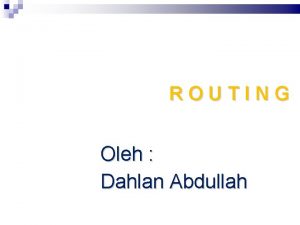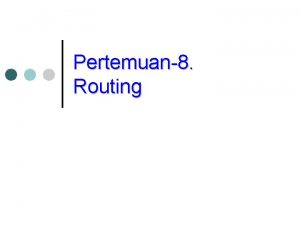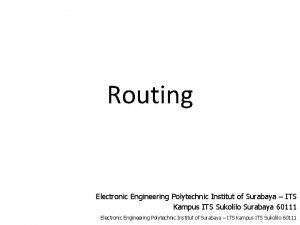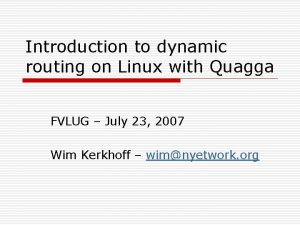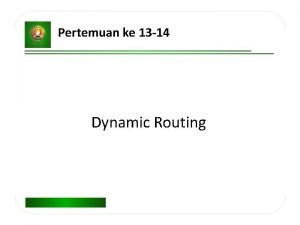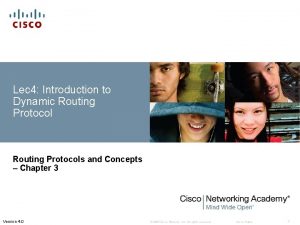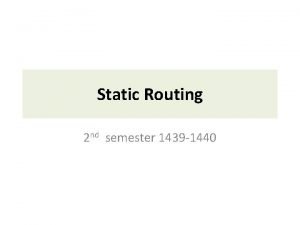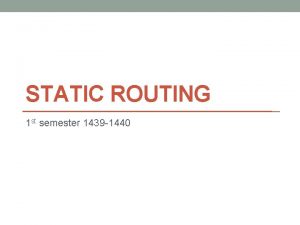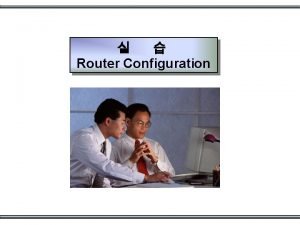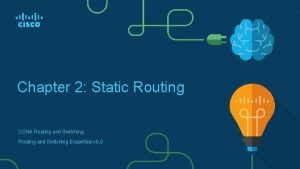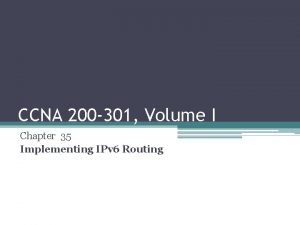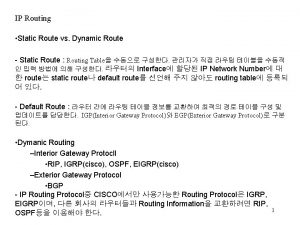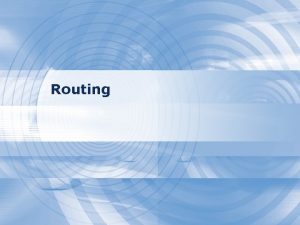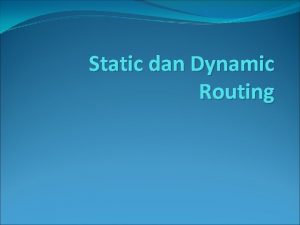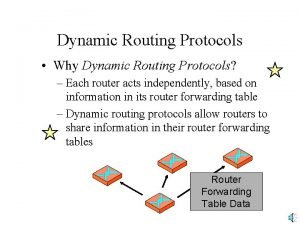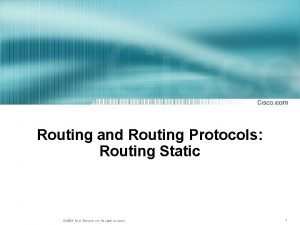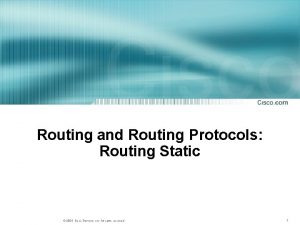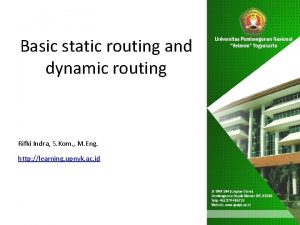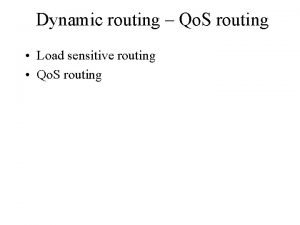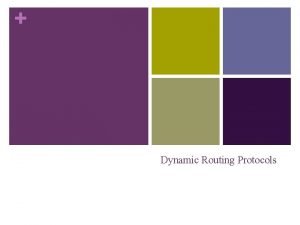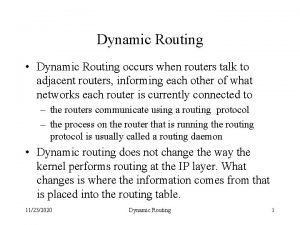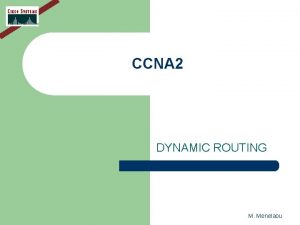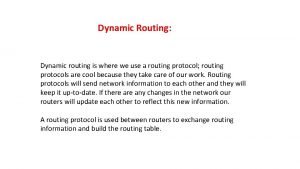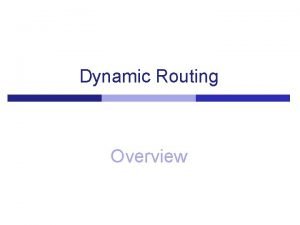Routing Why dynamic route 1 Static route is


































- Slides: 34

Routing

Why dynamic route ? (1) > Static route is ok only when – Network is small – There is a single connection point to other network – No redundant route 2

Why dynamic route ? (2) > Dynamic Routing – Routers update their routing table with the information – – of adjacent routers Dynamic routing need a routing protocol for such communication Advantage: • They can react and adapt to changing network condition 3

Routing Protocol > Used to change the routing table according to various routing information – Specify detail of communication between routers – Specify information changed in each communication, • • • Network reachability Network state Metric > Metric – A measure of how good a particular route • Hop count, bandwidth, delay, load, reliability, … > Each routing protocol may use different metric and exchange different information 4

Autonomous System > Autonomous System (AS) – Internet is organized in to a collection of autonomous system – An AS is a collection of networks with same routing policy • • Single routing protocol Normally administered by a single entity > Corporation or university campus • All depend on how you want to manage routing 5

Category of Routing Protocols – by AS > AS-AS communication – – Communications between routers in different AS Interdomain routing protocols Exterior gateway protocols (EGP) Ex: • BGP (Border Gateway Protocol) > Inside AS communication – – Communication between routers in the same AS Intradomain routing protocols Interior gateway protocols (IGP) Ex: • • • RIP (Routing Information Protocol) IGRP (Interior Gateway Routing Protocol) OSPF (Open Shortest Path First Protocol) 6

Category of Routing Protocols – by information changed (1) > Distance-Vector Protocol – Message contains a vector of distances, which is the cost – – to other network Each router updates its routing table based on these messages received from neighbors Protocols: • • • RIP IGRP BGP 7

Category of Routing Protocols – by information changed (2) > Link-State Protocol – Broadcast their link state to neighbors and build a complete – network map at each router using Dijkstra algorithm Protocols: • OSPF 8

Difference between Distance-Vector and Link-State > Update – Distance-Vector: – Link-State: updates neighbor (propagate new info. ) update all nodes – Distance-Vector: – Link-State: Propagation delay cause slow convergence Fast convergence – Distance-Vector: – Link-State: simple complex > Convergence: > Complexity: > Information update sequence Distance-Vector Link-State 9

Routing Protocols RIP IGRP OSPF BGP IGP, DV IGP, LS EGP

RIP – Routing Information Protocol

RIP (1) > Category – Interior routing protocol – Distance-vector routing protocol • Using “hop-count” as the cost metric > Example of how RIP advertisements work Routing table in router before Receiving advertisement Advertisement from other router A Routing table after receiving advertisement 12

RIP (2) > Another example 13

RIP Message Format > RIP message is carried in UDP datagram – Command: 1 for request and 2 for reply – Version: 1 or 2 (RIP-2) 20 bytes per route entry 14

RIP Operation > routed – RIP routing daemon – Operated in UDP port 520 > Operation – Initialization • • Probe each interface send a request packet out each interface, asking for other router’s complete routing table – Request received • Send the entire routing table to the requestor – Response received • Add, modify, delete to update routing table – Regular routing updates • Router sends out their routing table to every neighbor every 30 minutes – Triggered updates • Whenever a route entry’s metric change, send out those changed part routing table 15

Problems of RIP > Issues – 15 hop-count limits – Take long time to stabilize after the failure of a router or link – No CIDR > RIP-2 – EGP support • AS number – CIDR support 16

IGRP – Interior Gateway Routing Protocol

IGRP (1) > Similar to RIP – Interior routing protocol – Distance-vector routing protocol > Difference between RIP – Complex cost metric other than hop count • • delay time, bandwidth, load, reliability The formula – Use TCP to communicate routing information – Cisco System’s proprietary routing protocol 18

IGRP (2) > Advantage over RIP – Control over metrics > Disadvantage – Still classful and has propagation delay 19

OSPF – Open Shortest Path First

OSPF (1) > Category – Interior routing protocol – Link-State protocol > Each interface is associated with a cost – Generally assigned manually – The sum of all costs along a path is the metric for that path > Neighbor information is broadcast to all routers – Each router will construct a map of network topology – Each router run Dijkstra algorithm to construct the shortest path tree to each routers 21

OSPF Dijkstra Algorithm > Single Source Shortest Path Problem – Dijkstra algorithm use “greedy” strategy – Ex: 22

OSPF – Routing table update example (1) 23

OSPF – Routing table update example (2) 24

OSPF – summary > Advantage – Fast convergence – CIDR support – Multiple routing table entries for single destination, each for one type-of-service • Load balancing when cost are equal among several routes > Disadvantage – Large computation 25

BGP – Border Gateway Protocol

BGP > Exterior routing protocol – Now BGP-4 – Exchange network reachability information with other BGP systems > Routing information exchange – Message: • • Full path of autonomous systems that traffic must transit to reach destination Can maintain multiple route for a single destination – Exchange method • • Using TCP Initial: entire routing table Subsequent update: only sent when necessary Advertise only optimal path > Route selection – Shortest AS path 27

BGP Operation example > How BGP work – The whole Internet is a graph of autonomous systems – X Z • • Original: X A B C Z X advertise this best path to his neighbor W – W Z • W X A B C Z W X Z 28

Routing Protocols Comparison 29

routed and gated

routed > Routing daemon – Speak RIP (v 1 and v 2) – Supplied with most every version of UNIX – Two modes • • Server mode (-s) & Quiet mode (-q) Both listen for broadcast, but server will distribute their information – routed will add its discovered routes to kernel’s routing table – Support configuration file - /etc/gateways • Provide static information for initial routing table 31

gated (1) > Development – Originally coordinated by Cornell University – Turn over to the Merit Gate. D Consortium in 1992 • Free for academic users with license agreement > Supported routing protocols – Both interior and exterior, including • RIP (v 1, v 2), OSPF, BGP, IS-IS, EGP – It can share routes among different protocols > Configuration file – /etc/gated. conf > Runtime manipulation command – gdc 32

gated (2) > % gdc “command” – interface • Force gated to re-check the list of active NICs – reconfig • Force gated to re-read gated. conf – checkconf • Parse and check syntax of gated. conf – toggletrace {all|normal|policy|route|general} • Start or stop logging – stop | start | restart 33

gated (3) > /etc/gated. conf – Statements separated by semicolons > Class of statements: – Option – Network interface definition – Configuration of individual protocols – Static routes 34
 Mark tinka
Mark tinka Rip static
Rip static Reservoir routing and channel routing
Reservoir routing and channel routing Continuity equation hydrology
Continuity equation hydrology Clock routing
Clock routing Hey hey bye bye
Hey hey bye bye Tabel routing static
Tabel routing static Konfigurasi routing static
Konfigurasi routing static Electronic engineering
Electronic engineering Dynamic routing packet tracer
Dynamic routing packet tracer Linux dynamic routing
Linux dynamic routing Dynamic routing
Dynamic routing Introduction to dynamic routing protocols
Introduction to dynamic routing protocols Toi
Toi Ppc planning sheet
Ppc planning sheet Summary static route
Summary static route Floating static route
Floating static route Static route 설정
Static route 설정 Ip static route command cisco
Ip static route command cisco Unicast
Unicast Default static route command
Default static route command Dont ask why why why
Dont ask why why why Uml stands for
Uml stands for Transformer is a
Transformer is a West egg new york
West egg new york Define static in literature
Define static in literature Dynamic vs static character
Dynamic vs static character Definition of a dynamic character
Definition of a dynamic character Dynamic picture
Dynamic picture Static or dynamic character
Static or dynamic character Static vs dynamic linking
Static vs dynamic linking Bernoulli equation mass flow rate
Bernoulli equation mass flow rate Linkage editor and linking loader
Linkage editor and linking loader What is linking and loading
What is linking and loading Static and dynamic anthropometry
Static and dynamic anthropometry






